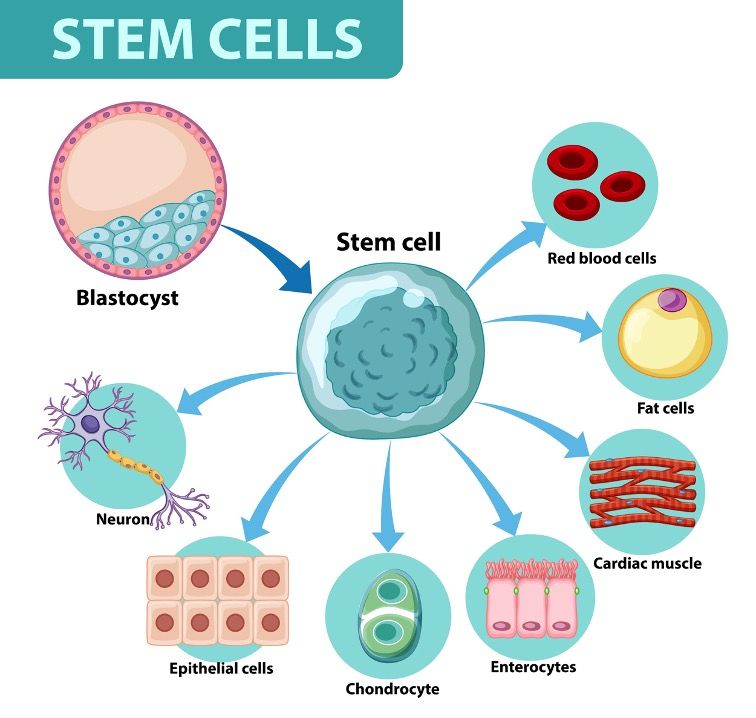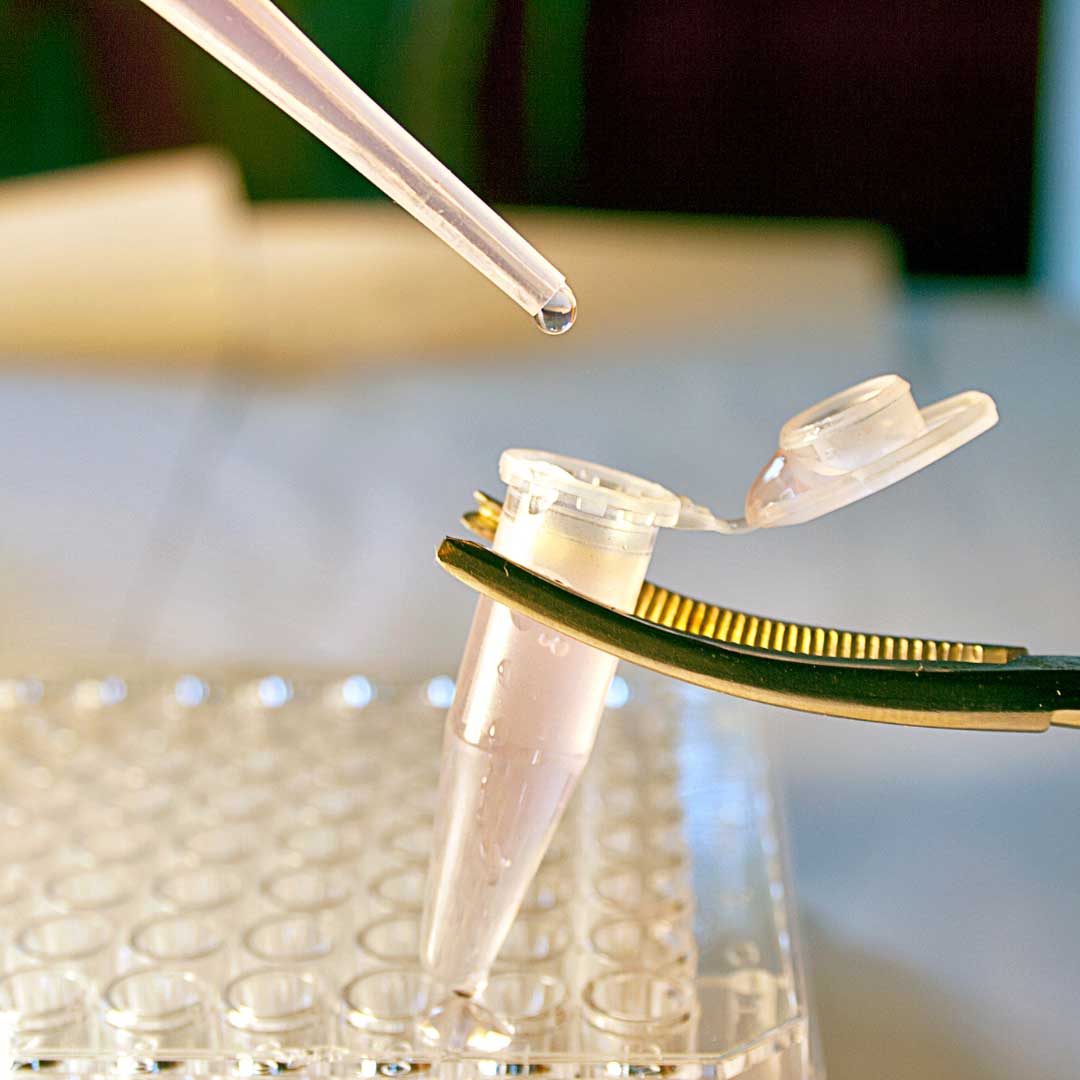This article is about the latest advancements in stem cell therapy for hair regeneration, shedding light on multipotent stem cell transplants, Conditioned Medium (CM) derived from stem cells, and the potential of stem cell-derived exosomes.
Stem cells are undifferentiated cells that can develop into any cell type within our bodies. Their ability to regenerate hair follicles is implemented in hair restoration.

Besides hair regeneration, stem cells are used in various treatments, such as brain disorders, spinal cord injury, blood cancers, etc.
During stem cell therapy, stem cells are collected from the patient's blood. These SCs are then processed and microinjected into the patient's scalp. But how do these stem cells promote hair regeneration?
● The injected stem cells migrate to the damaged or inactive hair follicles and release growth factors that activate dormant follicles and promote their regeneration.
● These stem cells transform into dermal papilla cells, crucial in regulating hair follicle development and function.
SCT offers an effective alternative for individuals experiencing various forms of alopecia or genetic predisposition to pattern baldness.
A 2018 study published in The Journal of dermatological treatment examined the safety and effectiveness of autologous bone marrow-derived mononuclear cells
(BMMCs) and follicular stem cells
(FSCs) in patients with alopecia areata (AA) and androgenetic alopecia (AGA). Both treatments showed significant improvement, with no adverse events reported. [1]
Recently, there has been a significant focus on multipotent stem-cell transplant, stem cell-derived conditioned medium (CM), and stem cell-derived exosomes as promising interventions in hair cycle progression and hair follicle regeneration.
1. Multipotent Stem-cell Transplant:
Multipotent stem cell transplant is one of the latest advancements in hair regeneration therapy.
A 2021 study published in the Stem Cell Research and Therapy has discovered that injecting adipose-derived stem cells into the scalp helps stimulate hair growth and increase hair density within 6 months. [2]
Procedure:
In this type of hair regeneration therapy, multipotent stem cells are taken from the patient's own body or a donor and then transplanted onto the scalp.
Multipotent stem cells for hair regeneration can be derived from various sources, including:
● Adipose tissue
● Bone marrow
● Unaffected hair follicles
● Umbilical cord blood
These SCs are injected directly into the areas where hair loss has occurred. These stem cells then stimulate dormant hair follicles, promoting new hair growth.
Benefits:
● Provides long-lasting results.
● Aims to restore natural hair growth by targeting the root cause of hair loss.
While still considered an emerging field, research surrounding multipotent stem cell transplant continues to evolve rapidly.
2. Stem Cells Derived - Conditioned Medium (CM)
Stem cells derived - Conditioned Medium (CM) is an exciting development in hair regeneration. CM refers to the fluid surrounding and nourishing stem cells, providing them with the necessary growth factors and nutrients for optimal function.
Moreover,
a 2020 research suggests that stem cells derived - CM helps stimulate dormant hair follicles, promote new hair growth, and increase hair density and hair thickness without showing any adverse reaction (including pain.) [3]
Procedure:
During this procedure, Conditioned Medium (CM) is isolated and cultured. It is then injected into the patient's scalp. By supplying essential nutrients directly to the scalp, it creates an environment conducive to healthy follicle activity.
Benefits:
● Promotes hair follicle growth without the need for surgery or invasive procedures.
● A good option for individuals who do not want to undergo surgery.
The regenerative properties of CM offer hope to those dealing with varying degrees of hair loss by encouraging new growth from existing follicles.
3. Stem Cells Derived Exosomes
Exosomes are small vesicles containing various bioactive molecules, including proteins, nucleic acids, and growth factors. These tiny packages are secreted by stem cells and are important in cell-to-cell communication.
Regarding hair regrowth, exosomes can stimulate the proliferation of dormant hair follicles and promote hair growth.
A recent 2020 study has demonstrated that exosome treatment can increase the number and thickness of hair shafts. [4] However, more preclinical, and clinical studies are required to assess the effectiveness of this technique.
Procedure:
Exosome therapy for hair loss involves injecting these potent particles directly into the scalp. It is a minimally invasive technique and does not require any surgery or incisions.
Benefits:
● No risk of immune rejection or tumor formation since they do not contain live cells.
● No surgical incision is required.
Stem cells derived- exosomes hold great potential as a non-invasive solution for stimulating hair growth in individuals experiencing various forms of alopecia. Further research will help refine this technique and expand its applications in clinical settings across the globe.
Individuals with mild to moderate hair loss tend to respond better to stem cell therapy. This is because the procedure stimulates dormant hair follicles and promotes new hair growth. Therefore, those with minimal balding or thinning are more likely to achieve positive results.
Candidates with healthy scalp conditions have higher chances of success. Stem cells need a conducive environment to thrive and flourish. If there are underlying scalp issues such as infections or severe inflammation, it may hinder the effectiveness of the treatment. Let's see which other individuals can benefit the most from stem cell therapy.
● Individuals suffering from all major kinds of Alopecia.
● Individuals with pattern hair loss.
● Individuals with bald patches or receding hairline.
Stem cell therapy for hair regeneration shows promise in research and offers hope for individuals dealing with hair loss, providing a natural and safe alternative to invasive procedures or medications with potential side effects. However, despite encouraging research results, further study on a larger scale of patients is necessary to fully understand its potential impact on individuals with bald patches, receding hairlines, and pattern hair loss.
1. Elmaadawi, I. H., Mohamed, B. M., Ibrahim, Z. A. S., Abdou, S. M., El Attar, Y. A., Youssef, A., Shamloula, M. M., Taha, A., Metwally, H. G., El Afandy, M. M., & Salem, M. L. (2018). Stem cell therapy is a novel therapeutic intervention for resistant alopecia areata and androgenetic alopecia cases. The Journal of dermatological treatment, 29(5), 431–440. https://doi.org/10.1080/09546634.2016.1227419
2. Kim, S. J., Kim, M. J., Lee, Y. J., Lee, J. C., Kim, J. H., Kim, D. H., Do, Y. H., Choi, J. W., Chung, S. I., & Do, B. R. (2021). An innovative method of alopecia treatment by autologous adipose-derived SVF. Stem cell research & therapy, 12(1), 486.
https://doi.org/10.1186/s13287-021-02557-6
3. Narita, K., Fukuoka, H., Sekiyama, T., Suga, H., & Harii, K. (2020). Sequential Scalp Assessment in Hair Regeneration Therapy Using an Adipose-Derived Stem Cell-Conditioned Medium. Dermatologic surgery: official publication for American Society for Dermatologic Surgery [et al.], 46(6), 819–825.
https://doi.org/10.1097/DSS.0000000000002128




